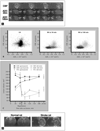Applications of diffusion/perfusion magnetic resonance imaging in experimental and clinical aspects of stroke
- PMID: 15191700
- PMCID: PMC2949944
- DOI: 10.1007/s11883-004-0057-y
Applications of diffusion/perfusion magnetic resonance imaging in experimental and clinical aspects of stroke
Abstract
The acute evaluation of stroke patients has undergone dramatic advances in the recent past. The increasing availability of novel magnetic resonance imaging (MRI) techniques, such as diffusion and perfusion MRI, provides a plethora of information to clinicians evaluating patients suspected of having an acute stroke. This review focuses on recent advances with experimental and clinical applications of perfusion and diffusion imaging and their utility in identifying potentially salvageable ischemic tissue in rat stroke model and stroke patients.
Figures


Similar articles
-
Role of diffusion and perfusion MRI in selecting patients for reperfusion therapies.Neuroimaging Clin N Am. 2011 May;21(2):247-57, ix-x. doi: 10.1016/j.nic.2011.01.002. Epub 2011 Mar 16. Neuroimaging Clin N Am. 2011. PMID: 21640298 Review.
-
The role of diffusion- and perfusion-weighted magnetic resonance imaging in drug development for ischemic stroke: from laboratory to clinics.Curr Vasc Pharmacol. 2004 Oct;2(4):343-55. doi: 10.2174/1570161043385493. Curr Vasc Pharmacol. 2004. PMID: 15320814 Review.
-
Investigating potentially salvageable penumbra tissue in an in vivo model of transient ischemic stroke using sodium, diffusion, and perfusion magnetic resonance imaging.BMC Neurosci. 2016 Dec 7;17(1):82. doi: 10.1186/s12868-016-0316-1. BMC Neurosci. 2016. PMID: 27927188 Free PMC article.
-
Diffusion and Perfusion MR Imaging in Acute Stroke: Clinical Utility and Potential Limitations for Treatment Selection.Top Magn Reson Imaging. 2017 Apr;26(2):77-82. doi: 10.1097/RMR.0000000000000124. Top Magn Reson Imaging. 2017. PMID: 28277459 Review.
-
Trial design and reporting standards for intra-arterial cerebral thrombolysis for acute ischemic stroke.Stroke. 2003 Aug;34(8):e109-37. doi: 10.1161/01.STR.0000082721.62796.09. Epub 2003 Jul 17. Stroke. 2003. PMID: 12869717
Cited by
-
Development and characterization of a Yucatan miniature biomedical pig permanent middle cerebral artery occlusion stroke model.Exp Transl Stroke Med. 2014 Mar 23;6(1):5. doi: 10.1186/2040-7378-6-5. Exp Transl Stroke Med. 2014. PMID: 24655785 Free PMC article.
-
Neuroimaging of stroke and ischemia in animal models.Transl Stroke Res. 2012 Mar;3(1):4-7. doi: 10.1007/s12975-011-0139-4. Epub 2011 Dec 10. Transl Stroke Res. 2012. PMID: 24323750
-
[Development of neuroradiology. From the visualization of bones to molecular imaging].Radiologe. 2005 Apr;45(4):327-39. doi: 10.1007/s00117-005-1192-3. Radiologe. 2005. PMID: 15800783 German.
-
Experimental models of brain ischemia: a review of techniques, magnetic resonance imaging, and investigational cell-based therapies.Front Neurol. 2014 Feb 19;5:19. doi: 10.3389/fneur.2014.00019. eCollection 2014. Front Neurol. 2014. PMID: 24600434 Free PMC article. Review.
-
Imaging Acute Stroke: From One-Size-Fit-All to Biomarkers.Front Neurol. 2021 Sep 23;12:697779. doi: 10.3389/fneur.2021.697779. eCollection 2021. Front Neurol. 2021. PMID: 34630278 Free PMC article. Review.
References
-
- Moseley ME, Cohen Y, Mintorovitch J, et al. Early detection of regional cerebral ischemia in cats: comparison of diffusion-and T2-weighted MRI and spectroscopy. Magn Reson Med. 1990;14:330–346. - PubMed
-
- Zhong J, Petroff AC, Prichard JW, Gore JC. Changes in water diffusion and relaxation properties of rat cerebrum during status epilepticus. Magn Reson Med. 1993;30:241–246. - PubMed
-
- van der Toorn A, Dijkhuizen RM, Tulleken CA, Nicolay K. Diffusion of metabolites in normal and ischemic rat brain measured by localized 1H MRS. Magn Reson Med. 1996;36:914–922. - PubMed
-
- Duong TQ, Ackerman JJ, Ying HS, Neil JJ. Evaluation of extra- and intracellular apparent diffusion in normal and globally ischemic rat brain via 19F NMR. Magn Reson Med. 1998;40:1–13. - PubMed
-
- Silva MD, Omae T, Helmer KG, et al. Separating changes in the intra- and extracellular water apparent diffusion coefficient following focal cerebral ischemia in the rat brain. Magn Reson Med. 2002;48:826–837. - PubMed
Publication types
MeSH terms
Grants and funding
LinkOut - more resources
Full Text Sources
Other Literature Sources
Medical
Miscellaneous
